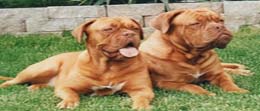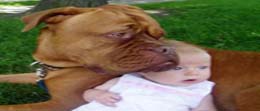All Dog Breeds >>Dogue de Bordeaux


(French mastiff, Bordeaux Bulldog) The Dogue de Bordeaux is a stout, burly mastiff breed with a thick-set body and a distinctive, massive-sized head. Their topline is level and blends into the rounded croup. The front limbs are heavy, well-boned, and parallel, and the tail is straight, thick at the base, and tapers to a point. The breed has a very large head that is heavy, wide, and wrinkled. Their jaw is strong and undershot and their muzzle is short. The breed's lips hang down over the lower jaw, and their nostrils are broad and open. The skin around the neck is loose and forms a pronounced dewlap. The Dogue de Bordeaux has a red or black facial mask and a soft, short-haired coat that exists in a variety of shades of fawn or mahogany. White markings on the toes and chest may be present.
Character
While the Dogue de Bordeaux was once a ferocious, merciless animal, breeders have softened the temperament of this breed to make it more suitable for life as a companion dog. Today, the Dogue de Bordeaux is calm, patient, and loyal. They are even-tempered and devoted to their family. Because of their fearlessness and confrontational demeanor, this breed also makes an excellent guard dog and watch dog. They can be very aggressive with other dogs, especially towards dogs of the same sex. The Dogue de Bordeaux should be socialized from an early age to prevent the onset of aggressive behavior. They are not a suitable choice for first-time dog owners. This breed is likely to drool and snore.
The Dogue de Bordeaux is known as a dissuasive guard dog that doesn't attach intruders but holds them at bay. They are never aggressive to other dogs if properly socialized and trained from a young age.
Weight
120 – 145 pounds
General Health
The Dogue de Bordeaux is a difficult dog to breed. Generally, their litters are very small, and cesarean sections are often needed at birth because of the breed's large-sized head. The Dogue de Bordeaux has a very broad, heavy chest, and pups are sometimes squashed by their mother while nursing. It's imperative for owners or breeders of the Dogue de Bordeaux to watch the pups vigilantly. This breed typically lives for 10 to 12 years.
History
The exact origin of the Dogue de Bordeaux is unknown. It's possible that the breed descended from the Greek and Roman Molossus, but it's just as likely that it arrived to Europe with the mastiff-type breeds that were brought by the Alans. Another possibility is that the Dogue de Bordeaux was developed from the dogs of Aquitaine, or that it was created from the Spanish dogs of Burgos. No matter which theory is true, the Dogue de Bordeaux is a very old breed. Because of its natural talents, strength, and abilities, the Dogue de Bordeaux has been utilized for many different purposes over the course of its long history. Some of these purposes include serving as a war dog, a flock guardian, and a combatant in dog gladiator sports. Towards the end of the middle ages, the breed was a personal body guard and a cattle driver. While many guard dogs were killed off during the French Revolution, there was enough of an interest in the Dogue de Bordeaux to ensure the breed's continued existence. The breed was saved by Raymond Triquet and his French Dogue de Bordeaux Club. The breed is thoroughly established in France and it is gaining popularity in other parts of the world. The breed is recognized by the FCI, but it is not yet recognized by the AKC.
The Dog de Bordeaux was accepted into the working group of the AKC in July 2008 and is gaining popularity in the show ring. It is also one of the most ancient French breeds, probably a descendant of the Alans and in particular, the Alan Vautre. Count of Foix said, in the14th century, that "he holds his bite stronger than three sight hounds".
Maintenance
The soft, short-haired coat of the Dogue de Bordeaux requires very little grooming or maintenance. This breed is a moderate shedder.
They are a moderate shedders. It's best to use a brush or a a towel with a small amount of hot water on it to rub down on a Dogue de Bordeaux until you can't get anymore hair off the dog.
Ideal Environment
The Dogue de Bordeaux is content to live in a small household or apartment if it is given sufficient daily exercise. They are a very inactive breed indoors, and they are happy without a yard. They need plenty of physical activity to remain fit and in a good state of mind.
Dogue de Bordeaux Training
The Dogue de Bordeaux is the hardest to train of all dog breeds. He learns new commands slower than all other breeds. You will need to be extra patient when Training him.